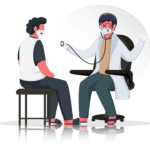Retrograde Ejaculation Treatment

Allo Health is dedicated to personalized well-being, offering support and trusted information tailored to individual health goals. The platform emphasizes human-generated content, led by a distinguished medical team of experts, including physicians and sexual health specialists. Their commitment to credibility involves rigorous fact-checking, authoritative research, and continuous updates to ensure accurate, up-to-date information. Allo Health's unique approach goes beyond conventional platforms, providing expert-led insights and a continuous commitment to excellence, with user feedback playing a crucial role in shaping the platform's authoritative voice.

Ms Ashima Sahore has a masters in Clinical Psychology and has been working avidly in the space of therapy and research for the past 2 years. Her expertise lies in areas of stress, depression, anxiety, improving self-esteem, confidence, body appreciation among many others. She imbibes a wholesome approach to therapy and provides a non-judgemental, LGBTQAI+, and safe space.
Why This Was Upated?
Our experts continually monitor the health and wellness space, and we update our articles when new information became available.
Updated on 02 June, 2024
- Article was updated as part of our commitment to diversity, equity, and inclusion.

"The following blog article may discuss medical treatments and interventions. However, it is important to note that the information provided is for general educational purposes only and should not be considered as a substitute for professional medical advice, diagnosis, or treatment. Always seek the guidance of a qualified healthcare professional for personalized medical advice.
Book consultation
Medical treatments are complex and should be tailored to individual circumstances. The information presented in this blog may not be applicable to everyone, as each person's medical condition, history, and needs are unique. Only a qualified healthcare professional can evaluate your specific medical situation, consider relevant factors, and provide appropriate recommendations for diagnosis, treatment options, and monitoring.
It is crucial to note that self-diagnosis, self-medication, or relying solely on the information provided in this blog for treatment decisions can have serious health consequences. "
Retrograde ejaculation is a condition that occurs when semen travels backwards into the bladder instead of being ejaculated out through the penis. This condition can cause infertility in men and can also lead to a decrease in sexual pleasure. There are several treatment options available for retrograde ejaculation, each with its own advantages and disadvantages.
Medication
One of the most common retrograde ejaculation fertility treatments is a medication under the supervision of a fertility specialist. Certain medications can help increase the pressure at the bladder neck, preventing semen from entering the bladder. These medications include:
- Sympathomimetic agents: These medications stimulate the nerves that control the bladder neck muscles, causing them to tighten and prevent semen from entering the bladder. Examples of these medications include ephedrine, pseudoephedrine, and phenylephrine.
- Anticholinergic agents: These medications relax the muscles in the bladder, allowing the bladder neck to close and preventing semen from entering the bladder. Examples of these medications include oxybutynin and tolterodine.
It is important to note that these medications should only be used under the guidance of a healthcare professional. They can have side effects, including increased blood pressure and heart rate, and may interact with other medications.
Medical devices
Medical devices can also be used as retrograde ejaculation fertility treatments. These devices are designed to prevent semen from entering the bladder and redirect it towards the urethra. Examples of medical devices used to treat retrograde ejaculation include:
- A retrograde ejaculation condom catheter: This device is placed over the penis before sexual intercourse. It has a one-way valve that prevents semen from entering the bladder and directs it towards the urethra.
- A sperm retrieval device: This device is used during medical procedures to collect semen from the bladder for use in fertility treatments
Medical devices can be effective in retrograde ejaculation fertility treatments, but they can also be uncomfortable and inconvenient to use. It is important to discuss the pros and cons of using medical devices with a healthcare professional.
Medical Procedures
Electroejaculation
- Electroejaculation is a medical procedure in which an electrical current is used to stimulate the nerves and muscles that control ejaculation.
- This procedure is typically done under general anaesthesia and involves inserting a probe into the rectum to stimulate the prostate gland and seminal vesicles.
- The electrical current causes muscles to contract, expelling semen through the penis.
- Electroejaculation is typically used in men who have spinal cord injuries or other conditions that prevent them from achieving ejaculation through normal sexual activity.
- While electroejaculation can be an effective treatment for retrograde ejaculation, it is an invasive procedure that requires general anaesthesia and carries some risk of complications, such as infection and bleeding.
Vibratory Stimulation
- Vibratory stimulation is a non-invasive treatment for retrograde ejaculation that uses a vibrating device to stimulate the nerves and muscles that control ejaculation.
- The device is typically placed on the underside of the penis and activated just before ejaculation.
- The vibration causes muscles to contract, expelling semen through the penis.
- Vibratory stimulation is a safe and effective treatment for retrograde ejaculation, with few reported side effects.
Lifestyle changes
Certain lifestyle changes can also help treat retrograde ejaculation and improve male fertility. These changes include:
- Avoiding medications that can cause retrograde ejaculation: If retrograde ejaculation is caused by medication side effects, stopping or changing medications may help treat the condition.
- Managing underlying medical conditions: If retrograde ejaculation is caused by an underlying medical condition, such as diabetes mellitus or multiple sclerosis, managing the condition may help treat the condition.
- Practising healthy habits: Maintaining a healthy diet, exercising regularly, and reducing stress can help improve overall health and potentially improve fertility.
Lifestyle changes are often recommended in conjunction with other retrograde ejaculation fertility treatments.

Surgery
In cases where medication is not effective or not appropriate, retrograde ejaculation surgery may be necessary. There are two main types of retrograde ejaculation surgery: transurethral resection of the ejaculatory ducts (TURED) and bladder neck reconstruction.
Transurethral Resection of the Ejaculatory Ducts (TURED)
- Transurethral resection of the ejaculatory ducts (TURED) is a minimally invasive surgery that is used to treat retrograde ejaculation by removing the blockages in the ejaculatory ducts.
- During the procedure, the surgeon will insert a small camera called a cystoscope through the urethra and into the bladder.
- The surgeon will then use specialized tools to remove any blockages in the ejaculatory ducts, which should allow semen to flow through the urethra during ejaculation.
The TURED procedure is typically performed under general anaesthesia and takes about an hour to complete. Most patients are able to go home the same day as the surgery and can resume normal activities within a week.
Bladder Neck Surgery Or Reconstruction
- Bladder neck reconstruction is a more invasive surgery that is used to treat retrograde ejaculation by reconstructing the bladder neck to improve the muscles’ ability to contract during ejaculation.
- During the procedure, the surgeon will make an incision in the lower abdomen and access the bladder.
- The surgeon will then remove the tissue that is blocking the bladder neck and reconstruct the area using sutures or other techniques.
Bladder neck reconstruction is typically performed under general anaesthesia and can take several hours to complete. Most patients will need to stay in the hospital for several days after the surgery, and recovery can take several weeks.
Risks and Complications
As with any surgery, there are risks and complications associated with retrograde ejaculation surgery. Some of the most common risks and complications include:
- Infection
- Bleeding
- Damage to surrounding organs or tissues
- Incontinence (inability to control urine flow)
- Erectile dysfunction
- Retrograde ejaculation may still occur after surgery
It is important to discuss the risks and benefits of retrograde ejaculation surgery with your doctor to determine if it is the right treatment option for you.
Fertility treatments
If retrograde ejaculation is causing male infertility, fertility treatments may be necessary to conceive a child. Fertility treatments can include:
- Intrauterine insemination (IUI): This procedure involves placing sperm directly into the uterus using a catheter. If retrograde ejaculation is causing male infertility, the sperm may need to be collected from the bladder using a sperm retrieval device.
- In vitro fertilization (IVF): This procedure involves combining sperm and egg in a laboratory setting and then transferring the resulting embryos to the uterus. If retrograde ejaculation is causing male infertility, the sperm may need to be collected from the bladder using a sperm retrieval device.
- Intracytoplasmic sperm injection (ICSI): This procedure involves injecting a single sperm directly into the egg in a laboratory setting. If retrograde ejaculation is causing male infertility, the sperm may need to be collected from the bladder using a sperm retrieval device.
Fertility treatments can be effective retrograde ejaculation fertility treatments, but they can also be expensive and invasive. It is important to discuss the pros and cons of fertility treatments with a healthcare professional.

Counselling
- Retrograde ejaculation counselling can help men with this condition by providing them with the knowledge and tools they need to manage their symptoms and improve their sexual health.
- Counselling can also help men understand the causes of their retrograde ejaculation and develop strategies for preventing it from occurring in the future.
- During counselling sessions, men will work with a therapist to address any psychological issues that may be contributing to their retrograde ejaculation.
- This may involve exploring any anxieties or fears that the man may have about sex, as well as addressing any relationship problems or communication issues that may be present.
- In addition to addressing psychological issues, retrograde ejaculation counselling can also provide men with practical strategies for managing their symptoms. This may include strategies for improving the strength and control of the muscles that control the bladder, as well as strategies for reducing the impact of medications or other factors that may be contributing to the condition.
- Retrograde ejaculation counselling can also provide men with education and information about the condition, including the causes and potential complications of retrograde ejaculation, as well as the treatment options that are available.
- This can help men make informed decisions about their treatment and can empower them to take an active role in managing their symptoms.
What to Expect During Retrograde Ejaculation Counseling
If you are considering retrograde ejaculation counselling, you may be wondering what to expect during your sessions. Typically, retrograde ejaculation counselling involves working with a trained therapist or counsellor who has experience in treating sexual dysfunction.
During your first session, your therapist will likely ask you a variety of questions about your symptoms, medical history, and sexual history. This information will help your therapist understand the underlying causes of your retrograde ejaculation and develop a treatment plan that is tailored to your specific needs.
Depending on your needs, your retrograde ejaculation counselling may involve a variety of techniques and strategies. Some common techniques that may be used during retrograde ejaculation counselling include:
- Cognitive-behavioural therapy (CBT): This type of therapy focuses on identifying negative thoughts and behaviours that may be contributing to your retrograde ejaculation and replacing them with more positive thoughts and behaviours.
- Kegel exercises: These exercises involve contracting and relaxing the muscles that control the bladder and can help improve bladder control and reduce the risk of retrograde ejaculation.
- Medication management: If your retrograde ejaculation is caused by medication, your therapist may work with you to adjust your medications or develop alternative treatment strategies.
- Communication skills training: If your retrograde ejaculation is caused by relationship problems or communication issues, your therapist may provide you with training in effective communication and conflict resolution.
Throughout your retrograde ejaculation counselling, your therapist will work with you to track your progress and adjust your treatment plan as needed. With time and persistence, retrograde ejaculation counselling can help you manage your symptoms and improve your sexual health.
Prognosis of Retrograde Ejaculation
- The prognosis for retrograde ejaculation depends on the underlying cause and the severity of the condition. In some cases, retrograde ejaculation may resolve on its own without treatment. In other cases, treatment may be necessary to improve symptoms and increase the chances of conception.
- Medications such as pseudoephedrine, imipramine, and brompheniramine have been shown to be effective in treating retrograde ejaculation caused by medication side effects. However, these medications may have side effects of their own and may not be effective in all cases.
- If retrograde ejaculation is caused by diabetes or nerve damage, treatment may involve managing blood sugar levels or using medications to improve nerve function.
- If retrograde ejaculation is caused by surgery or radiation therapy, treatment may involve using medication or undergoing electroejaculation.
- In cases where retrograde ejaculation is causing infertility, fertility treatments such as IUI or IVF may be recommended. These treatments can be successful in helping couples conceive, but the success rates can vary depending on the severity of the condition and other factors.
- It is important to talk to your doctor for medical advice about the best treatment option for you, as each treatment option has its own advantages and disadvantages. With the right treatment plan, many men with retrograde ejaculation are able to successfully achieve pregnancy and enjoy a healthy and satisfying sex life.
Summary
- Retrograde ejaculation occurs when semen goes into the bladder, potentially leading to infertility and reduced sexual pleasure.
- Treatment options encompass medication, medical devices, procedures like electroejaculation and vibratory stimulation, lifestyle changes, surgery, fertility treatments, and counseling.
- Medication increases pressure at the bladder neck, preventing semen from entering the bladder. Medical devices redirect semen towards the urethra.
- Lifestyle changes involve avoiding medications causing retrograde ejaculation, managing underlying conditions, and maintaining a healthy lifestyle.
- Surgery options include TURED (removing blockages) and bladder neck reconstruction (enhancing muscle contraction during ejaculation).
- Fertility treatments like IUI, IVF, and ICSI may be considered for infertility due to retrograde ejaculation.
- Counseling addresses psychological and practical aspects, providing education, strategies, and support.
- Prognosis depends on the cause and severity. Treatment may resolve the cocnern or be necessary. Success varies based on the chosen approach.
Frequently Asked Questions
Q: How is retrograde ejaculation diagnosed?
A: Retrograde ejaculation is diagnosed by analyzing a urine sample collected immediately after ejaculation. Presence of sperm in the urine indicates the condition. Additionally, medical history and physical examination may be used to confirm the diagnosis.
Q: How does a urine sample help in diagnosing retrograde ejaculation?
A: A urine sample is crucial in diagnosing retrograde ejaculation as it allows for the detection of sperm in the urine, a clear indication of the condition. Additionally, a cloudy urine sample due to the presence of semen, further confirms the diagnosis.
Q: What are the possible causes of retrograde ejaculation?
A: Retrograde ejaculation can be caused by nerve damage, muscle damage, certain medications (like blood pressure medications and antidepressants), or conditions like diabetes that affect nerve function. Additionally, surgical procedures or anatomical abnormalities in the bladder neck can contribute to this condition.
Q: What are the common treatment options for retrograde ejaculation?
A: Common treatment options include medication, medical devices, procedures like electroejaculation and vibratory stimulation, lifestyle changes, surgery, fertility treatments, and counseling.
Q: How effective are medications in treating retrograde ejaculation?
A: Medications can be effective, especially in cases where retrograde ejaculation is caused by medication side effects. However, their effectiveness may vary, and they may not work for all individuals.
Q: What are the risks associated with surgery for retrograde ejaculation?
A: Risks may include infection, bleeding, damage to surrounding tissues, incontinence, erectile dysfunction, and the possibility of retrograde ejaculation persisting after surgery.
Q: Is retrograde ejaculation reversible with treatment?
A: In some cases, retrograde ejaculation may be reversible with appropriate treatment. The prognosis depends on the underlying cause and the severity of the condition.






































